Guide to becoming a Data Driven organisation
Date: Wednesday, August 4, 2021
“The importance of data to the modern enterprise is no longer a topic of debate. The sheer volume of data that organisations capture, store, and organise continues to grow at a staggering pace. In an age of data, suddenly, every business is a data business. Although the transformational potential of data is practically limitless, most organisation’s still struggle to fully realise the value of their data.” Gartner 2021
On average, organisations are only using 20-25% of their data to make day to day and strategic business decisions. The other 75-80% of data tends to be locked away in applications, spreadsheets, transactional systems etc.
The majority of organisations are undervaluing the data they hold and need to be able to turn this into management information.
There has been a fundamental shift in recent years when it comes to how businesses think about and use data – from isolated and project-orientated data usage to a completely data-driven culture across an organisation. Business Intelligence is realised when everyone in the organisations has easy access to data-insights that are relevant to them and help them make better, more informed decisions.
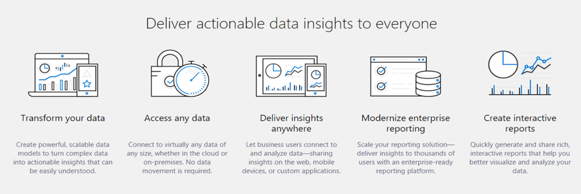
What is the definition of a data-driven culture?
A data-driven culture is about moving from gut feeling and decision-making based on isolated or incomplete information, to treating data as the main resource for leveraging insights in every department across the organisation.
While companies have always been interested in the numbers, in data-driven organisations the extent of data use and their commitment to accessing 100% of business data for decision-making is central to their business strategy.
The first step to becoming a data-driven organisation is to identify which level of data transformation your organisation is currently operating at. The diagram below lays out five stages to becoming a truly data-driven organisation (level 5).
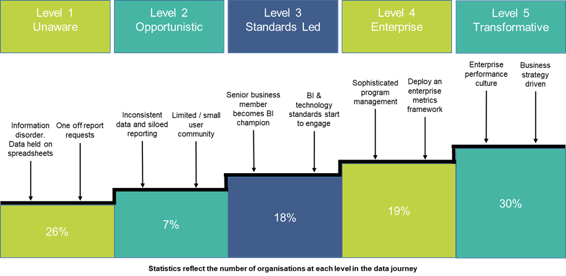
Level 3 is where an organisation has definitely started the journey. They will have a senior business member who becomes a business intelligence champion which is key. At this stage you may have even identified the data toolsets you want to use.
Gartner’s Magic Quad for BI and Analytics 2021, shows that the three technology leaders in this space are Microsoft (Power BI), Tableau and Qlik. These organisations have made vast investment in their BI platforms and replaced the more traditional toolsets that were the former leaders in the Quad, SAP Business Objects and IBM Cognos to name just two.
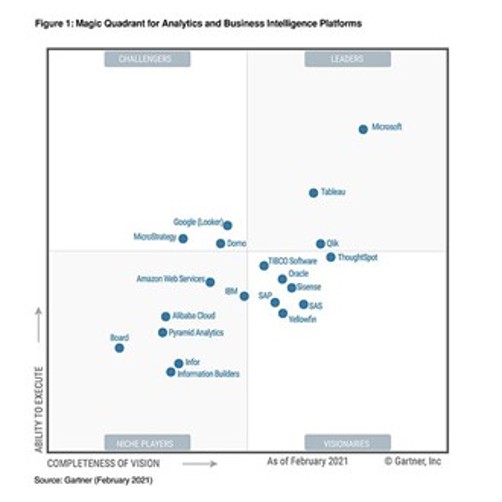
BI Strategy – what this might look like
At its core, a Business Intelligence (BI) strategy needs to be focused on driving better decisions through data. The focus of a BI strategy has really changed over the last 2-3 years. To create a data-driven culture you have to think differently about BI projects than you probably have done to date.
Up until recently the general focus for most BI projects has been on how to integrate data from multiple data sources, how to get the data into a repository, and then how to create dashboard reporting - creating standard reports that the business has asked for (financial reports, sales reports, customer analysis etc).
Thinking of Business Intelligence in these terms is not moving the organisation forward in terms of becoming “data driven”. As shown in this diagram, the scenario we have just described uses data sources as the starting point (bottom of the diagram) and works up from there.
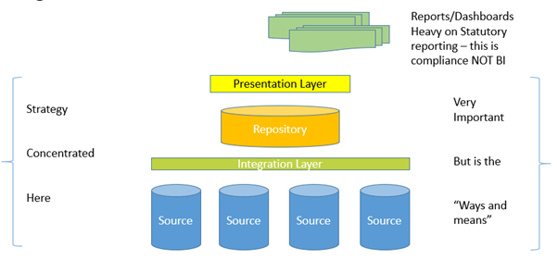
Typically, businesses focus too much on the solution design (bottom up).
However, truly data-driven organisations turn this thinking process on its head and start with their analytics strategy i.e., understanding what data analytics information they need to drive the business forward. They then work downwards from this point.
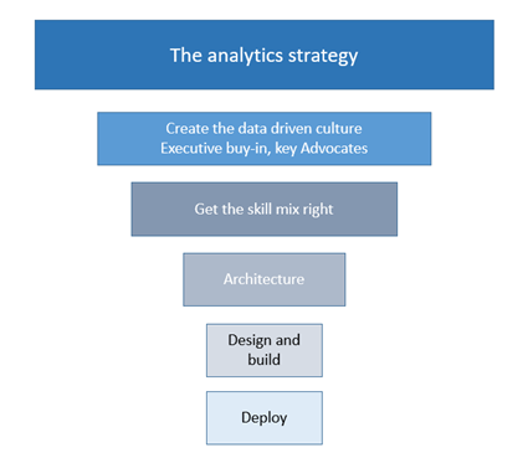
The analytics strategy should not be done in isolation by any single group or department. It needs to be done with contribution from each and every department within the organisation.
Village Software help organisations to workshop their analytics strategy department by department with consistent input from the client’s central informatics team.
These workshops tease out answers to the critical question:
“What information would enable you to run your department better, increase the performance of your department, and to provide you with the insights you need to make better decisions?”
Up until recently, focus has typically been concentrated on the how to integrate data held on different platforms and data sources and create dashboards and insights from it. This still needs to be done and is very important, however, rather than acting as the starting point of a project this now becomes simply “The ways and means” to deliver the analytics the business itself has decided it needs, department by department (see the Architecture and Design & Build stages in the diagram above).
Why it’s important to start with the analytics strategy
Your analytics strategy needs to be built around the requirements of each department. If not, the data architecture and integration that you create is unlikely to deliver the insights your departments need. In which case the project has not improved decision-making and the organisation hasn’t moved forward.
For example, a business may have integrated data successfully from multiple data applications. But if the production manager or Head of HR doesn’t have information that’s very specific to them, then they aren’t in a position to use data to make better decisions, and therefore the data integration project has not been a success. The organisation has not moved forward in terms of becoming data driven.
The success of the project should be measured on:
- Is each department is getting what they asked for?
- Is the data helping each department make better decisions which are moving the organisation forward in line with its agreed strategic goals?
A Blueprint for Success
In helping and guiding our clients to build capabilities for success in terms of creating a data-driven organisation, Village Software follow a framework that is based on the Tableau Blueprint. We have found that this is as good as anything to focus the organisation on putting the Analytics Strategy as the foundation of the BI Project.
This Blueprint provides a starting point and a defined roadmap for organisations who are in the early stages of their journey. It creates visibility to the areas organisations may struggle with as they attempt to implement and roll out projects.
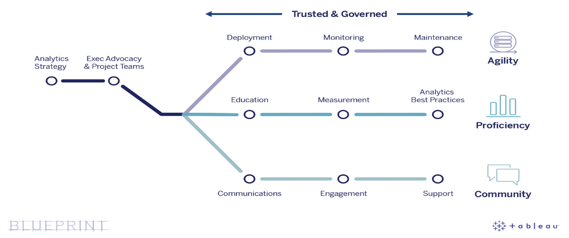
Analytics Strategy & Exec Advocacy
The purpose of the analytics strategy workshops we run with our clients is to help them (and us) understand which analytics need to be provided department by department. Our advice is always to start with the most engaged department first – the ones that are receptive and enthusiastic about becoming more data-driven.
Start with the departments that are really interested. Identify and educate advocates or champions within these departments who will demonstrate to the rest of the business how they have better management information as a result of the BI solution they have in place.
If you have successful departments then the others will want to follow.
Agility - Start with small work packages which deliver success quite quickly. Quick success is possible with the Microsoft and Tableau toolsets. Continue to monitor how new information is being used within the department and help users to learn how to become much more data driven in their day-to-day roles. Again, Village Software will support you through this stage.
Proficiency – Changing the norm of how people behave and operate requires education and support. Without this, people are less likely to adopt to new ways of working. Through education, measurement and instilling best-practice department by department, skills increase, confidence builds, habits alter, and that’s when change really begins.
Community – By working department by department and tackling small work packages which deliver quick successes, you will start to develop a community of advocates and evangelists within the organisation. Community builds culture – to develop a successful data-driven culture within your organisation building an engaged community is key.
Key considerations in building a data-driven culture
- Executive sponsorship
- Choosing the key people to be advocates
- Analytics strategy – what will actually move the organisation forward?
- Architecture (Cloud, on premise, hybrid)
- Preferred toolsets (Microsoft Power BI, Tableau)
Further help
Village Software deliver a half-day session to help organisations plan their Analytics Strategy. Using the Village BI strategy framework this session is designed to help you:
- Identify key department advocates and sponsors.
- Identify key analytics requirements for each part of your business.
- Ascertain the required data sources.
- Agree the solutions architecture.
- Agree key people as well as in-house and Village resource input style.
- Agree next steps.
Please get in touch for further information.
Other related resources
- GUIDE – Download Business Intelligence for Business Leaders: overcoming everyday data issues which you are able to download here.
- For further blogs and insights please visit our website.
About Village Software
Village Software Engineering design and build incredible software solutions with the single aim of improving your business.
We specialise in Data Analytics & BI, Bespoke Software, and Enterprise Integration. Our team of innovative and skilled developers work across many sectors including manufacturing, education, transportation and logistics, healthcare, utilities and retail.
Leaders in our field, we provide application development, enterprise integration and business intelligence software solutions that embrace leading edge technologies and methods.
Our curiosity and intelligent thinking help us to deliver quality solutions that don’t just work but work for you.
Technology partners
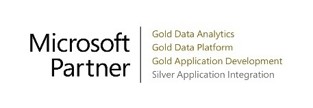



 About Us
About Us Services
Services Sectors
Sectors Case Studies
Case Studies Blog
Blog Contact
Contact



